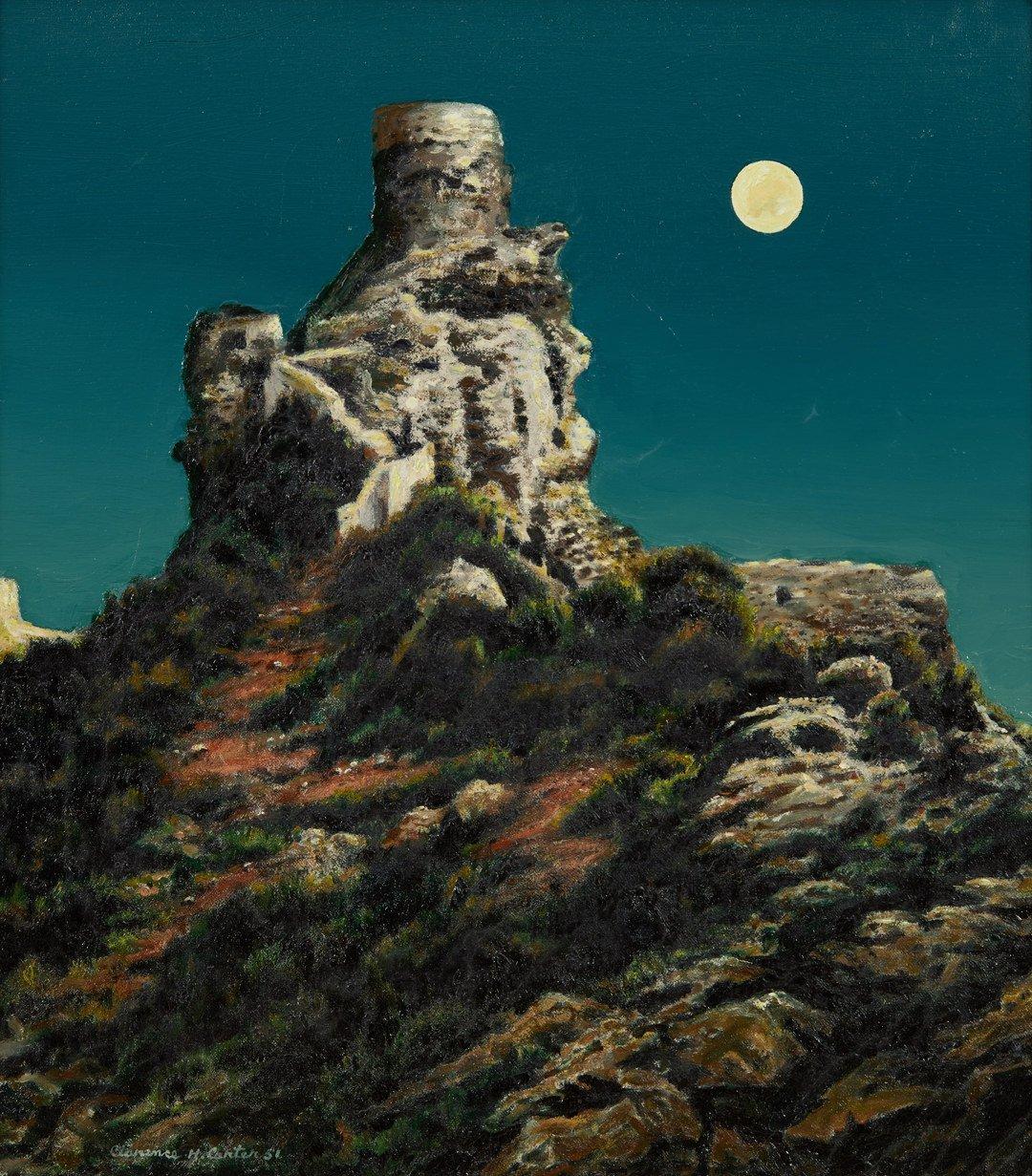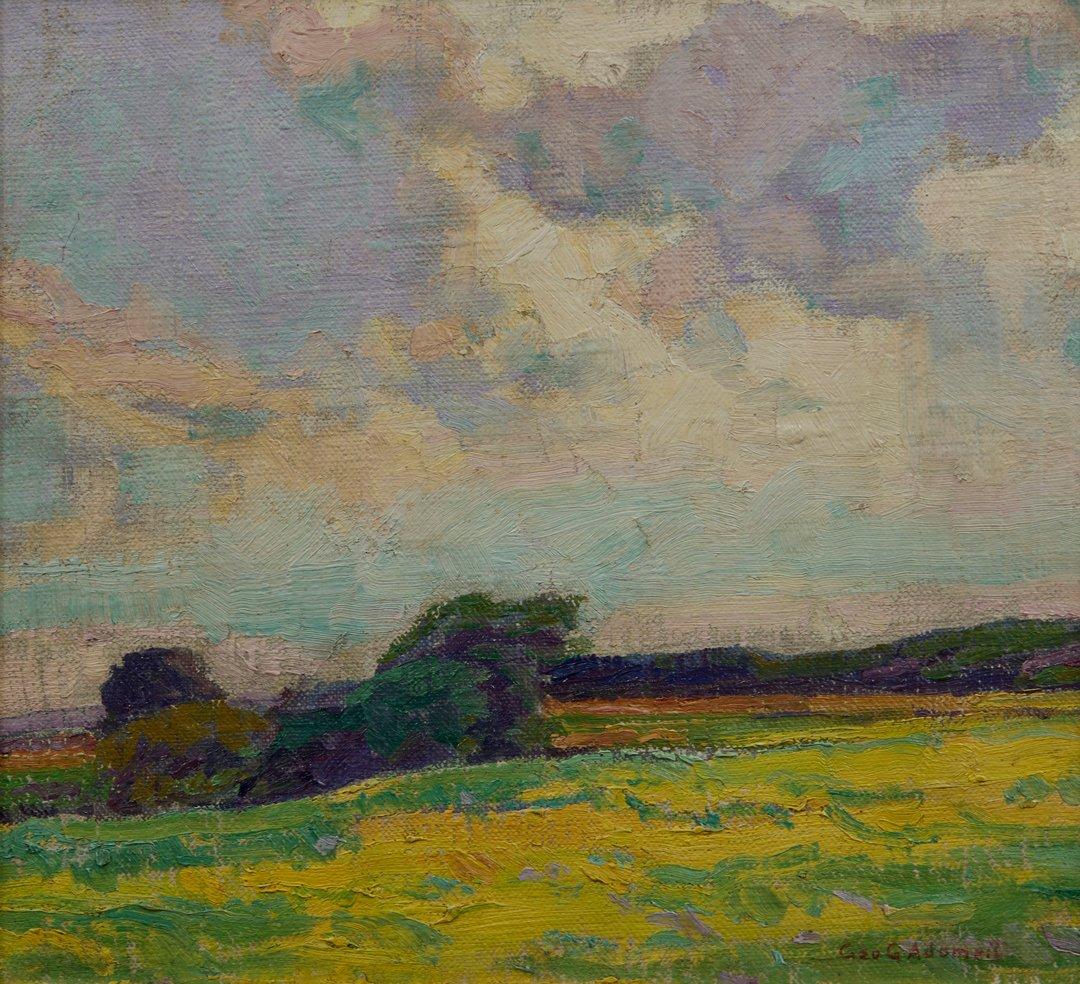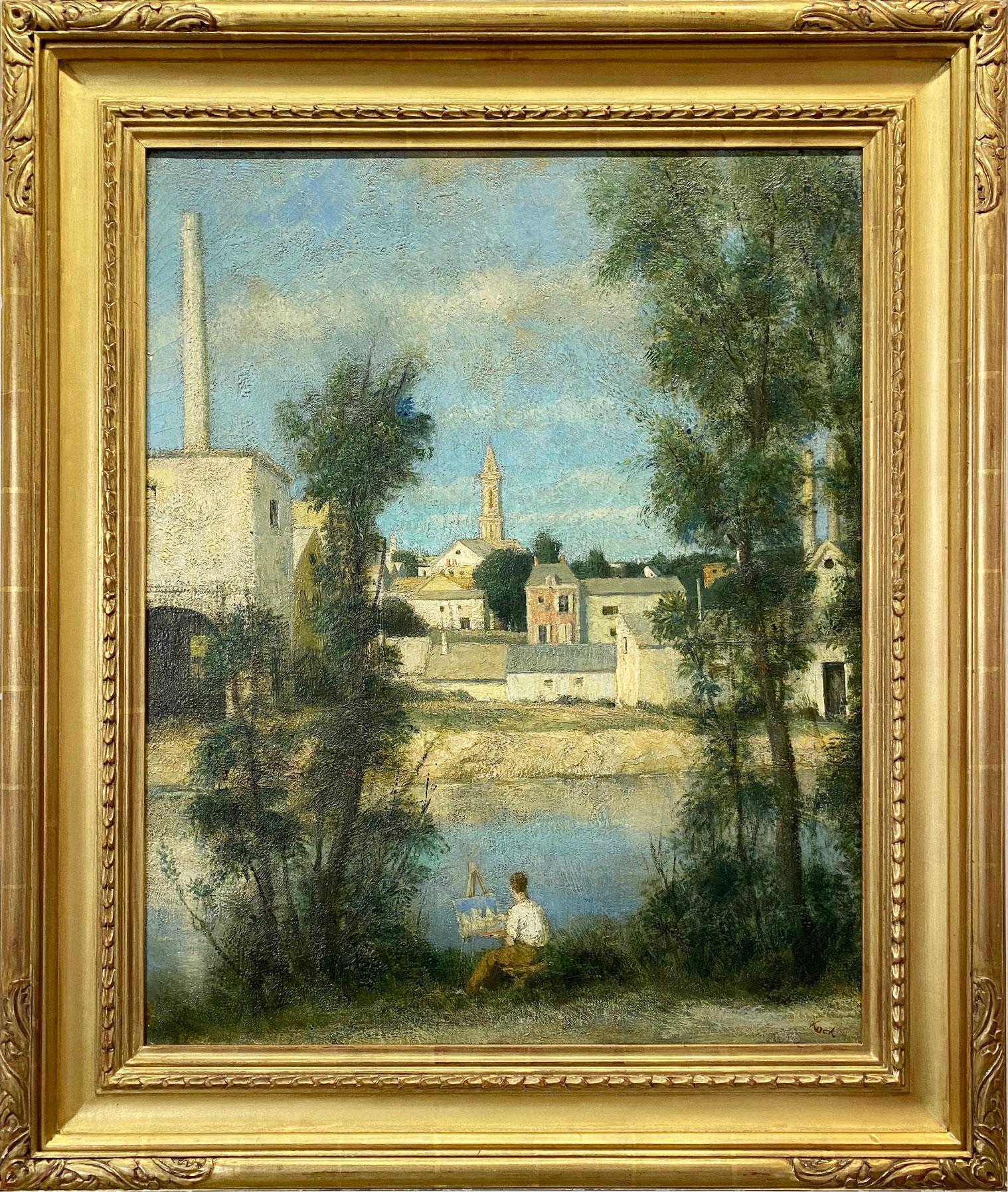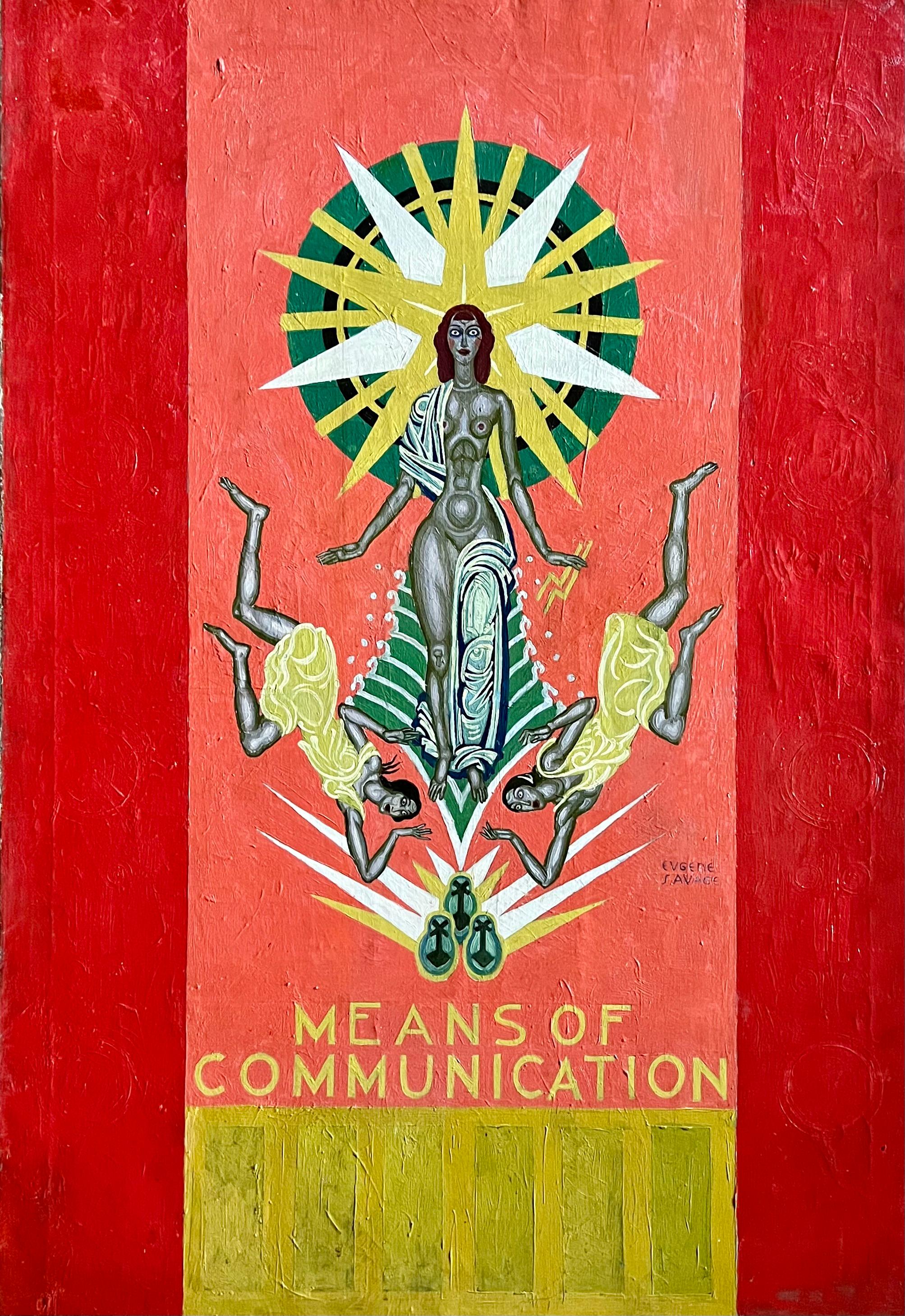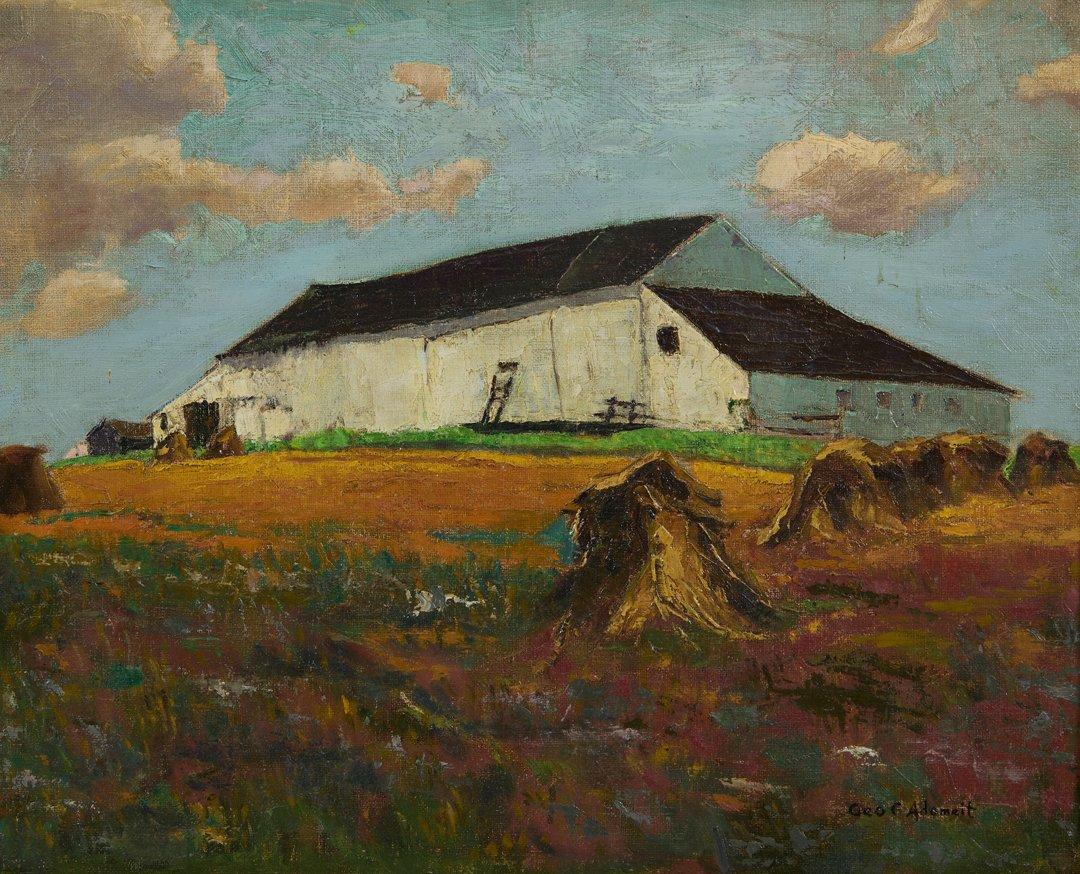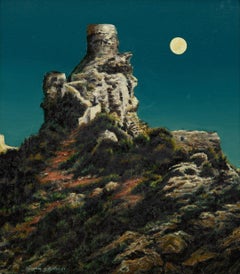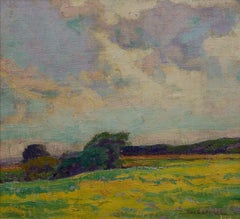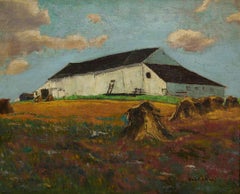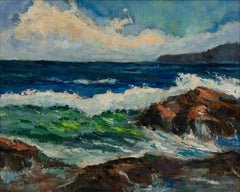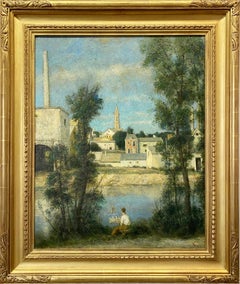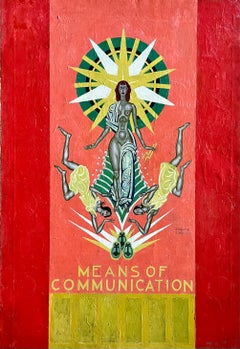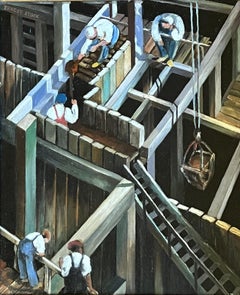Items Similar to 19th Century Landscape of Shepherdess w/ Sheep & Dog, Munich, Cleveland School
Want more images or videos?
Request additional images or videos from the seller
1 of 7
Henry Keller19th Century Landscape of Shepherdess w/ Sheep & Dog, Munich, Cleveland School1891
1891
About the Item
Henry George Keller (American, 1869–1949)
Shepherdess with Sheep and Dog, Munich, 1891
Oil on canvas
Signed and dated lower left
19 x 24 inches
25 x 30 inches, framed
Keller, a leading painter in Cleveland, was born at sea, off Nova Scotia on April 3, 1869. His earliest training was in Karlsruhe, Germany under Hermann Baisch (1846-1894), then at the Cleveland School of Art, the Cincinnati Fine Arts Academy and the Art Students League in New York. The young artist was an apprentice at the W. J. Morgan Lithograph Company, also in Cleveland. Keller polished off his art instruction at the Munich Academy (1899-1902) with Heinrich Johann Zügel (1850-1941), chiefly an animal painter. There he would have rubbed shoulders with Walt Kuhn. At the end of his stay in Munich, he won a silver medal. His watercolor, Santa Maria della Salute, in a private collection, is in the tradition of John Singer Sargent. According to Arthur Covey, Keller was back in Munich in 1904-05, and he mentioned a painting called Storm-frightened Animals (Weimer, 1940, pp. 570-572). In Munich, Keller also met William Sommer, a future Cleveland post-impressionist.
Back in America, Keller immediately found a job at the Art Institute of Pittsburgh then he taught at his alma mater, the Cleveland School of Art until 1945. In Cleveland, remarked Keller (in Milliken, 1950), there was "a kind of pale, timid, watered Impressionism" and he reacted against it. Charles Burchfield, one of his more famous students, studied at the Cleveland School of Art between 1912 and 1916, when Keller was studying Asian art and showing modernist tendencies, having surpassed impressionism. Keller was also an enthusiast of Diaghelev's Ballets Russes, which he saw on their American tour. He studied the psychology of color with Dr. J. J. R. Macleod and underwent Cézanne's influence. Also at that time, Keller exhibited two works at the Armory Show — Wisdom and Destiny (Cleveland Museum of Art) and The Valley (unlocated). The former shows Keller's more traditional, intellectual side, with its classical allegorical figures in a stormy landscape. The theme was inspired by one of Maurice Maeterlinck's essays. Keller's modernism is revealed in the contemporary watercolor entitled Sunflower, in the same museum, which recalls some of the bravura of the free brushwork of John Marin. Keller was part of a group called the Cleveland Independents.
The list of Keller's exhibition activities is truly amazing — from local venues in Cleveland to Chicago (including a special show of his wash drawings in May of 1920), Pittsburgh, Philadelphia, and New York, his works were on view year by year. The Cleveland Museum of Art presented him with awards on numerous occasions and in 1939, he was elected to the National Academy of Design. That year, his painting Circus Day was on display at the Golden Gate International Exposition in San Francisco, while at the New York World's Fair in 1939, his Horse Barn appeared in the exhibition of contemporary artists. Here the horses are closer to those of German Expressionist Franz Marc than to those of Degas. The Whitney Museum has Keller's charcoal and watercolor, Bird Rock, California (1925). The painter died in San Diego, on August 3, 1949.
- Creator:Henry Keller (1869 - 1949, American)
- Creation Year:1891
- Dimensions:Height: 19 in (48.26 cm)Width: 24 in (60.96 cm)
- Medium:
- Movement & Style:
- Period:
- Condition:
- Gallery Location:Beachwood, OH
- Reference Number:1stDibs: LU1768214697352
About the Seller
5.0
Gold Seller
Premium sellers maintaining a 4.3+ rating and 24-hour response times
Established in 1975
1stDibs seller since 2022
23 sales on 1stDibs
Typical response time: 4 hours
- ShippingRetrieving quote...Shipping from: Beachwood, OH
- Return Policy
Authenticity Guarantee
In the unlikely event there’s an issue with an item’s authenticity, contact us within 1 year for a full refund. DetailsMoney-Back Guarantee
If your item is not as described, is damaged in transit, or does not arrive, contact us within 7 days for a full refund. Details24-Hour Cancellation
You have a 24-hour grace period in which to reconsider your purchase, with no questions asked.Vetted Professional Sellers
Our world-class sellers must adhere to strict standards for service and quality, maintaining the integrity of our listings.Price-Match Guarantee
If you find that a seller listed the same item for a lower price elsewhere, we’ll match it.Trusted Global Delivery
Our best-in-class carrier network provides specialized shipping options worldwide, including custom delivery.More From This Seller
View AllTorre di Tiberio, Tower of Tiberius, Capri, Italy Landscape, Cleveland School
By Clarence Holbrook Carter
Located in Beachwood, OH
Clarence Holbrook Carter (American, 1904-2000)
Torre di Tiberio, 1951
Oil on canvas
Signed and dated lower left
21 x 18 inches
28.5 x 26.5 inches, framed
Clarence Holbrook Carter ac...
Category
1950s American Modern Figurative Paintings
Materials
Oil
Early 20th Century Summer Landscape, Cleveland School Artist
By George Adomeit
Located in Beachwood, OH
George Gustav Adomeit (American, 1879-1967)
Summer Landscape
Oil on canvas board
Signed lower right
13 x 14.25 inches
18.25 x 19.5 inches, framed
A major painter of American scene s...
Category
Early 20th Century American Modern Figurative Paintings
Materials
Oil
20th Century Landscape of a Barn with Haystacks, Cleveland School Artist
By George Adomeit
Located in Beachwood, OH
George Gustav Adomeit (American, 1879-1964)
Barn Scene
Oil on canvas mounted to masonite
Signed lower right
16 x 20 inches
21.5 x 25.5 inches, framed
A major painter of American sce...
Category
Early 20th Century American Modern Figurative Paintings
Materials
Oil
Coastal Scene, 20th Century Seascape, Cleveland School Artist
By George Adomeit
Located in Beachwood, OH
George Gustav Adomeit (American, 1879-1967)
Coastal Scene
Oil on canvas
Signed lower left
19 x 23 inches
21.5 x 25.5 inches, framed
A major painter of American scene subjects, Georg...
Category
20th Century American Modern Figurative Paintings
Materials
Oil
Mid-20th Century Venetian Canal Cityscape, Italian-American artist
By Louis Bosa
Located in Beachwood, OH
Louis Bosa (American, 1905-1981)
Venice Canalscape, c. 1950
Oil on board
Signed lower right
11.75 x 21.75 inches
19.75 x 29.75 inches, framed
Born in Codroipo, a small village only ...
Category
1950s American Modern Figurative Paintings
Materials
Oil
House in Hudson, Ohio, Late 19th Century Painting by Cleveland School Artist
Located in Beachwood, OH
Ora Coltman (American, 1858-1940)
House in Hudson, OH
Oil on canvas
Signed lower left
22 x 26 inches
27.5 x 31.5 inches, framed
21 Aurora Street is locally known as the Isham-Beebe ...
Category
Late 19th Century American Modern Figurative Paintings
Materials
Oil
You May Also Like
American Pastoral
By John Koch
Located in Greenwich, CT
John Koch is a beloved American realist painter who depicted people in their everyday lives. Here we see a slightly different approach where he has put a painter out in a rural town...
Category
1940s American Modern Landscape Paintings
Materials
Canvas, Oil
NYC 1939 World's Fair Mural Study American Scene WPA Modern Mid 20th Century
Located in New York, NY
NYC 1939 World's Fair Mural Study American Scene WPA Modern Mid 20th Century
Eugene Savage (1883 – 1978)
1939 World’s Fair Mural Study
45 x 30 inches
Oil on Canvas
Signed lower right
The painting is part of a 1,000 piece collection of art and objects from the 1939 World’s Fair. The collection as a whole is available.
Savage created the mural for the facade of the Communications Building. An image of the completed mural, along with a published postcard, is part of the listing. Note the center top female figure, she resembles the figure in the offered painting.
BIO
Eugene Francis Savage was born in Covington, Indiana 1883. He underwent various forms of art training in the early years. He was a pupil of The Corcoran Gallery and The Art Institute of Chicago, and was later awarded a fellowship to study in Rome at The American Academy.
While under the spell of that ancient city the young artist began to render historic figures that were suitable for the classic style needed for mural painting in the traditional manor. During this period he was able to study and observe Roman and Greek sculpture, although much of the academic training was accomplished by using plaster casts along with the incorporation of live models. This method survived and was used efficiently throughout Europe and the United States.
After leaving the Academy, Savage was commissioned to paint numerous murals throughout the United States and Europe. This artist received acclaim for the works he produced while under commissions from various sources. This young master was a contemporary of Mexican muralists David Alfaro Siqueiros (1896-1974), Jose Clemente Orozco (1883-1949) and Diego Rivera (1886-1957). In this period he was to show the influence of his contemporaries in formulating a modern style. Savage also played a vital role in the WPA Federal Art program, and he was a member of The Mural Art Guild..
Savage was elected an associate member of The National Academy of Design in 1924 and a full member in 1926. From 1947, he held a professorship at Yale University where he taught mural painting, and some of his students went on to significant positions.
By this time the artist had painted large-scale murals at Columbia, Yale University, Buffalo N.Y., Dallas, Texas, Chicago, Indiana, along with other commissioned works. He also achieved recognition for a series of murals commissioned by the Matson Shipping Line and completed around 1940. For this commission, Savage made many exacting studies of customs and folkways of the Hawaiian natives. However, the award-winning murals were not installed as planned but were put in storage during the war years when the ships were used for troop transportation and were in danger of attack.
However the mural images were reproduced and distributed by the shipping company including nine of the mural scenes that were made into lithographed menu covers in 1948. The American Institute of Graphic Arts awarded certificates of excellence for their graphic production, and the Smithsonian Institute exhibited the works in 1949. Today Savages' Hawaiian Art production is held in high regard by collectors of Hawaiian nostalgia.
In later years the artist focused his attention on a theme that dealt with the customs and tribal traditions of the Seminole Indians of Florida. He produced many variations of this theme throughout his lifetime, and the pictures were usually modest scale easel paintings, precise and carefully delineated. Many of these pictures incorporate Surrealistic elements and show some minor stylistic influences of the painters Kay Sage...
Category
1930s American Modern Figurative Paintings
Materials
Canvas, Oil
A Pair of Modern Impressionist Landscape Oil Paintings Framed Female artist NY
Located in Buffalo, NY
A Pair of Modernist Landscapes by listed female artist Margaret Munro Stratton McLennan.
Margaret was a painter working in the early 20th Century in the Syracuse area. These charmi...
Category
1920s American Modern Landscape Paintings
Materials
Board, Oil
Subway Construction
Located in Los Angeles, CA
This painting is part of our exhibition American Coast to Coast: Artists of the 1930s
Subway Construction, c. 1928, oil on board, 19 x 15 ¾ inches, signed upper left, artist and title verso; exhibited: 1) 12th Annual Exhibition of the Society of Independent Artists, The Waldorf Astoria, New York NY, from March 9 to April 1, 1928, no. 864 (original price $250) (see Death Prevailing Theme of Artists in Weird Exhibits, The Gazette (Montreal, Quebec, Canada), March 8, 1928); 2) Boston Tercentenary Exhibition Fine Arts and Crafts Exhibition, Horticultural Hall, Boston MA, July, 1930, no. 108 (honorable mention - noted verso); 3) 38th Annual Exhibition of American Art, Cincinnati Art Museum, Cincinnati, OH, June, 1931 (see Alexander, Mary, The Week in Art Circles, The Cincinnati Enquirer, June 7, 1931); and 4) National Art Week Exhibition [Group Show], Montross Gallery, New York, New York, December, 1940 (see Devree, Howard, Brief Comment on Some Recently Opened Exhibitions in the Galleries, The New York Times, December 1, 1940)
About the Painting
Ernest Stock’s Subway Construction depicts the excavation of New York’s 8th Avenue line, which was the first completed section of the city-operated Independent Subway System (IND). The groundbreaking ceremony was in 1925, but the line did not open until 1932, placing Stock’s painting in the middle of the construction effort. The 8th Avenue line was primarily constructed using the “cut and cover” method in which the streets above the line were dug up, infrastructure was built from the surface level down, the resulting holes were filled, and the streets reconstructed. While many artists of the 1920s were fascinated with the upward thrust of New York’s exploding skyline as architects and developers sought to erect ever higher buildings, Stock turned his attention to the engineering marvels which were taking place below ground. In Subway Construction, Stock depicts workers removing the earth beneath the street and building scaffolding and other support structures to allow concrete to be poured. Light and shadow fall across the x-shaped grid pattern formed by the wooden beams and planks. It is no surprise that critics reviewing the painting commented on Stock’s use of an “interesting pattern” to form a painting that is “clever and well designed.”
About the Artist
Ernest Richard Stock was an award-winning painter, print maker, muralist, and commercial artist. He was born in Bristol, England and was educated at the prestigious Bristol Grammar School. During World War I, Stock joined the British Royal Air Flying Corps in Canada and served in France as a pilot where he was wounded. After the war, he immigrated to the United States and joined the firm of Mack, Jenny, and Tyler, where he further honed his architectural and decorative painting skills. During the 1920s, Stock often traveled back and forth between the US and Europe. He was twice married, including to the American author, Katherine Anne Porter. Starting in the mid-1920s, Stock began to exhibit his artwork professionally, including at London’s Beaux Arts Gallery, the Society of Independent Artists, the Salons of America, the Cincinnati Art Museum, the Whitney Studio and various locations in the Northeast. Critics often praised the strong design sensibility in Stock’s paintings. Stock was a commercial illustrator for a handful of published books and during World War II, he worked in the Stratford Connecticut...
Category
1920s American Modern Figurative Paintings
Materials
Oil
Colorado Hill Town with Storm Clouds, 1940s Modernist Landscape, Lush Green
By Paul Kauver Smith
Located in Denver, CO
This WPA-era signed oil painting by Paul K. Smith captures a stormy summer landscape in Colorado, featuring houses and lush trees under dramatic storm clouds. Painted in rich shades ...
Category
1940s American Modern Landscape Paintings
Materials
Oil
"Spring Ploughing" Georgina Klitgaard, Modernist American Farmed Landscape
By Georgina Klitgaard
Located in New York, NY
Georgina Klitgaard
Spring Ploughing
Signed lower right
Oil on canvas
34 x 42 inches
Georgina Klitgaard’s art has sometimes gotten lost in the critical propensity to assign artists ...
Category
1940s American Modern Landscape Paintings
Materials
Canvas, Oil
